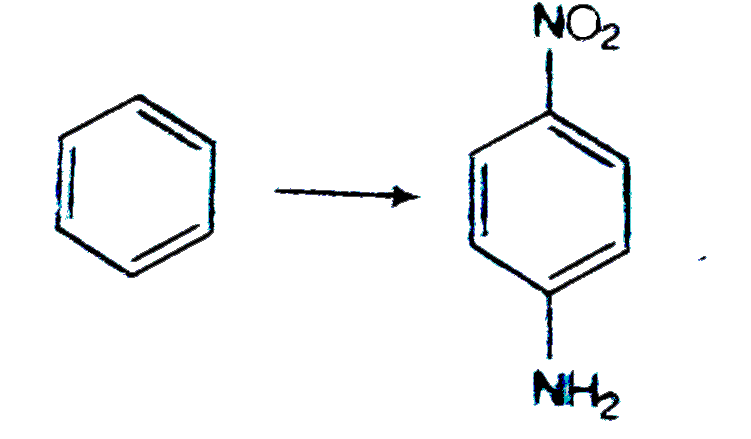How will you bring out the following conversions ?
Ethene to ethyne
To convert ethene (C2H4) to ethyne (C2H2), we can follow these steps:
Step 1: Bromination of Ethene
- Reaction: Ethene (C2H4) reacts with bromine (Br2) in the presence of carbon tetrachloride (CCl4).
- Equation:
C2H4+Br2CCl4−−−→C2H4Br2
- Explanation: This is an addition reaction where bromine adds across the double bond of ethene, resulting in a dibromo compound (C2H4Br2).
Step 2: Dehydrohalogenation
- Reaction: The dibromo compound (C2H4Br2) undergoes dehydrohalogenation using alcoholic potassium hydroxide (KOH).
- Equation:
C2H4Br2alc.KOH−−−−−→C2H2Br+HBr
- Explanation: In this step, hydrogen bromide (HBr) is eliminated, resulting in a bromoalkene (C2H2Br).
Step 3: Second Dehydrohalogenation
- Reaction: The bromoalkene (C2H2Br) undergoes another dehydrohalogenation using sodium amide (NaNH2).
- Equation:
C2H2BrNaNH2−−−−−→C2H2+HBr
- Explanation: Here, HBr is eliminated again, leading to the formation of ethyne (C2H2).
Alternative Method:
- Instead of using sodium amide in the last step, you can use alcoholic KOH again to achieve the same dehydrohalogenation and obtain ethyne.
Final Reaction Summary:
1. Ethene + Br2 → Dibromo compound (C2H4Br2)
2. Dibromo compound + Alcoholic KOH → Bromoalkene (C2H2Br) + HBr
3. Bromoalkene + NaNH2 (or alcoholic KOH) → Ethyne (C2H2) + HBr
- Reaction: Ethene (C2H4) reacts with bromine (Br2) in the presence of carbon tetrachloride (CCl4).
- Equation:
C2H4+Br2CCl4−−−→C2H4Br2
- Explanation: This is an addition reaction where bromine adds across the double bond of ethene, resulting in a dibromo compound (C2H4Br2).
- Reaction: The dibromo compound (C2H4Br2) undergoes dehydrohalogenation using alcoholic potassium hydroxide (KOH).
- Equation:
C2H4Br2alc.KOH−−−−−→C2H2Br+HBr
- Explanation: In this step, hydrogen bromide (HBr) is eliminated, resulting in a bromoalkene (C2H2Br).
- Reaction: The bromoalkene (C2H2Br) undergoes another dehydrohalogenation using sodium amide (NaNH2).
- Equation:
C2H2BrNaNH2−−−−−→C2H2+HBr
- Explanation: Here, HBr is eliminated again, leading to the formation of ethyne (C2H2).
- Instead of using sodium amide in the last step, you can use alcoholic KOH again to achieve the same dehydrohalogenation and obtain ethyne.
1. Ethene + Br2 → Dibromo compound (C2H4Br2)
2. Dibromo compound + Alcoholic KOH → Bromoalkene (C2H2Br) + HBr
3. Bromoalkene + NaNH2 (or alcoholic KOH) → Ethyne (C2H2) + HBr
Topper's Solved these Questions
- HYDROCARBONS BOOK - ICSECHAPTER - HYDROCARBONS EXERCISE - ESSAY (LONG ANSWER) TYPE QUESTIONS
28 Videos
- HYDROCARBONS BOOK - ICSECHAPTER - HYDROCARBONS EXERCISE - OBJECTIVE (MULTIPLE CHOICE) TYPE QUESTIONS
71 Videos
- HYDROCARBONS BOOK - ICSECHAPTER - HYDROCARBONS EXERCISE - VERY SHORT ANSWER TYEP QUESTIONS
47 Videos
- EQUILIBRIUM BOOK - ICSECHAPTER - EQUILIBRIUM EXERCISE - NCERT TEXT-BOOK EXERCISE
109 Videos
- HYDROGENBOOK - ICSECHAPTER - HYDROGENEXERCISE - NCERT TEXT-BOOK EXERCISE (With Hints and Solutions)
53 Videos
Similar Questions
How will you bring about the following conversions ?

View SolutionHow will you bring out the following conversions ?
Ethane to ethyne
View SolutionHow will you bring out the following conversions ?
Ethyne to ethane
View SolutionHow will you bring out the following conversions ?
Ethyne to methane
View SolutionHow will you bring out the following conversions ?
Ethyne to but-2-yne
View SolutionHow will you carry out the following conversion?

View SolutionHow will you carry out the following conversion?

View SolutionHow will you carry out the following conversion?

View SolutionHow will you carry out the following conversion?

View SolutionHow will you carry out the following conversion?

View Solution
